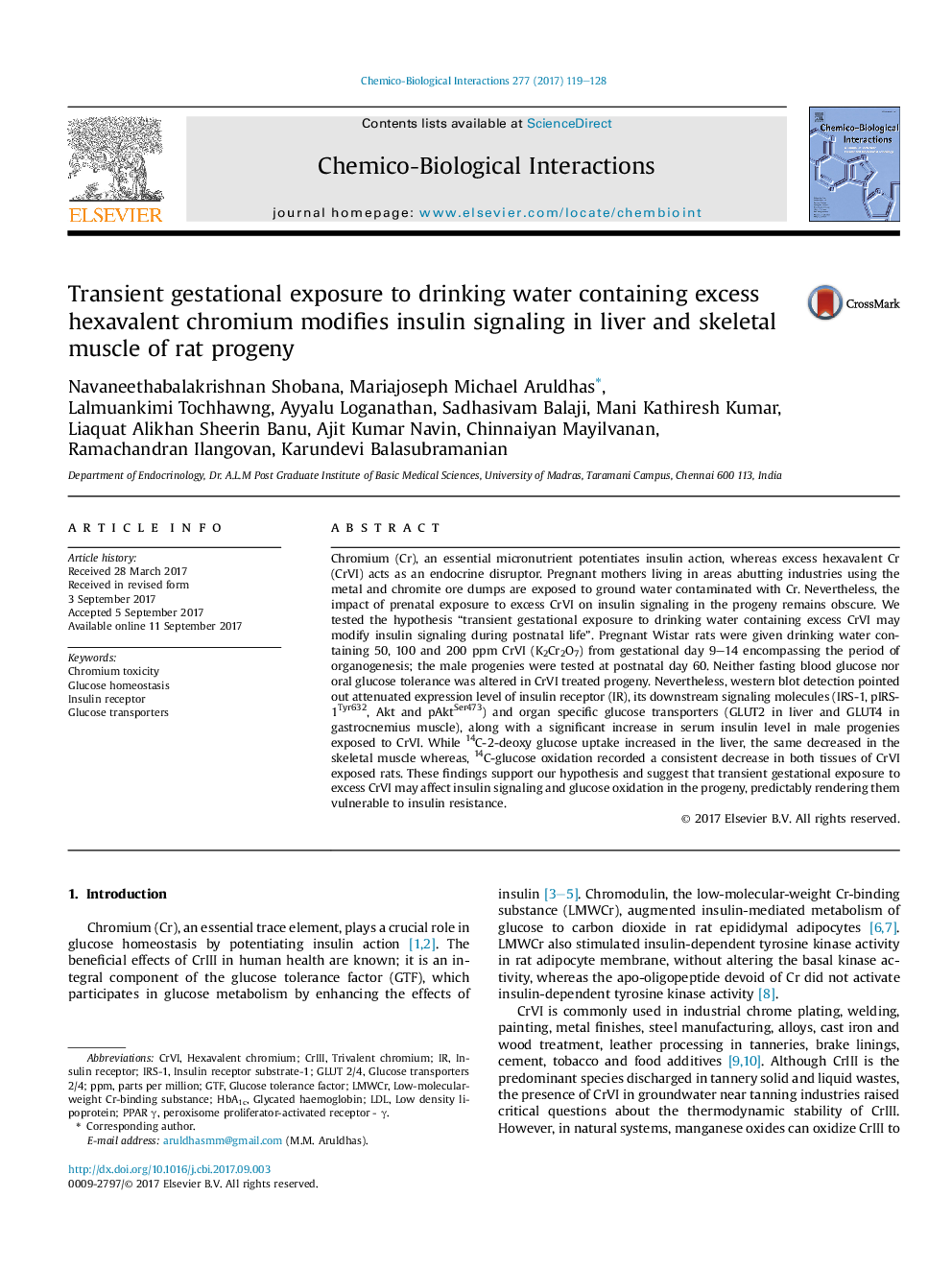| کد مقاله | کد نشریه | سال انتشار | مقاله انگلیسی | نسخه تمام متن |
|---|---|---|---|---|
| 5559351 | 1561565 | 2017 | 10 صفحه PDF | دانلود رایگان |
- Gestational exposure of CrVI leads to impaired insulin signaling in liver and skeletal muscles.
- No change in fasting glucose and OGT was observed.
- IR protein level was decreased in both the tissues.
- Protein expression of insulin signaling downstream molecules like IRS-1, pIRS-1Tyr632, Akt and pAktSer473 were altered.
- Organ specific glucose transporters were altered.
Chromium (Cr), an essential micronutrient potentiates insulin action, whereas excess hexavalent Cr (CrVI) acts as an endocrine disruptor. Pregnant mothers living in areas abutting industries using the metal and chromite ore dumps are exposed to ground water contaminated with Cr. Nevertheless, the impact of prenatal exposure to excess CrVI on insulin signaling in the progeny remains obscure. We tested the hypothesis “transient gestational exposure to drinking water containing excess CrVI may modify insulin signaling during postnatal life”. Pregnant Wistar rats were given drinking water containing 50, 100 and 200Â ppm CrVI (K2Cr2O7) from gestational day 9-14 encompassing the period of organogenesis; the male progenies were tested at postnatal day 60. Neither fasting blood glucose nor oral glucose tolerance was altered in CrVI treated progeny. Nevertheless, western blot detection pointed out attenuated expression level of insulin receptor (IR), its downstream signaling molecules (IRS-1, pIRS-1Tyr632, Akt and pAktSer473) and organ specific glucose transporters (GLUT2 in liver and GLUT4 in gastrocnemius muscle), along with a significant increase in serum insulin level in male progenies exposed to CrVI. While 14C-2-deoxy glucose uptake increased in the liver, the same decreased in the skeletal muscle whereas, 14C-glucose oxidation recorded a consistent decrease in both tissues of CrVI exposed rats. These findings support our hypothesis and suggest that transient gestational exposure to excess CrVI may affect insulin signaling and glucose oxidation in the progeny, predictably rendering them vulnerable to insulin resistance.
Effect of transient gestational exposure (9-14GD) to CrVI on insulin signaling in liver and gastrocnemius muscle of puberal progeny rats.The impact of excess CrVI on insulin receptor signaling is represented by red coloured arrows. Once CrVI enters the cell, it undergoes reduction reaction to attain stable oxidation state CrIII, releasing free radicals. These excess ROS generated can cause DNA damage indirectly, CrIII can enter the nucleus and form Cr-DNA adducts thereby damaging DNA directly. These forms of Cr damage, present physical barriers to DNA replication/transcription. A) CrVI exposure decreased IR, IRS1 and pIRS-1Tyr632 protein in liver of CrVI treated rats. Phosphorylated form pAktSer473 was upregulated in CrVI treated rats. The increase in GLUT2 protein had lead to increased glucose uptake but impaired oxidation in liver of rats exposed to higher dose of CrVI. B) CrVI exposure decreased IR protein in gastrocnemius muscle of CrVI treated rats. Akt and its phosphorylated form pAktSer473 got downregulated in gastrocnemius muscle of puberal rats exposed to excess CrVI during gestational period (9-14GD). The decrease in GLUT4 protein leads to impaired glucose uptake and oxidation.363
Journal: Chemico-Biological Interactions - Volume 277, 1 November 2017, Pages 119-128
